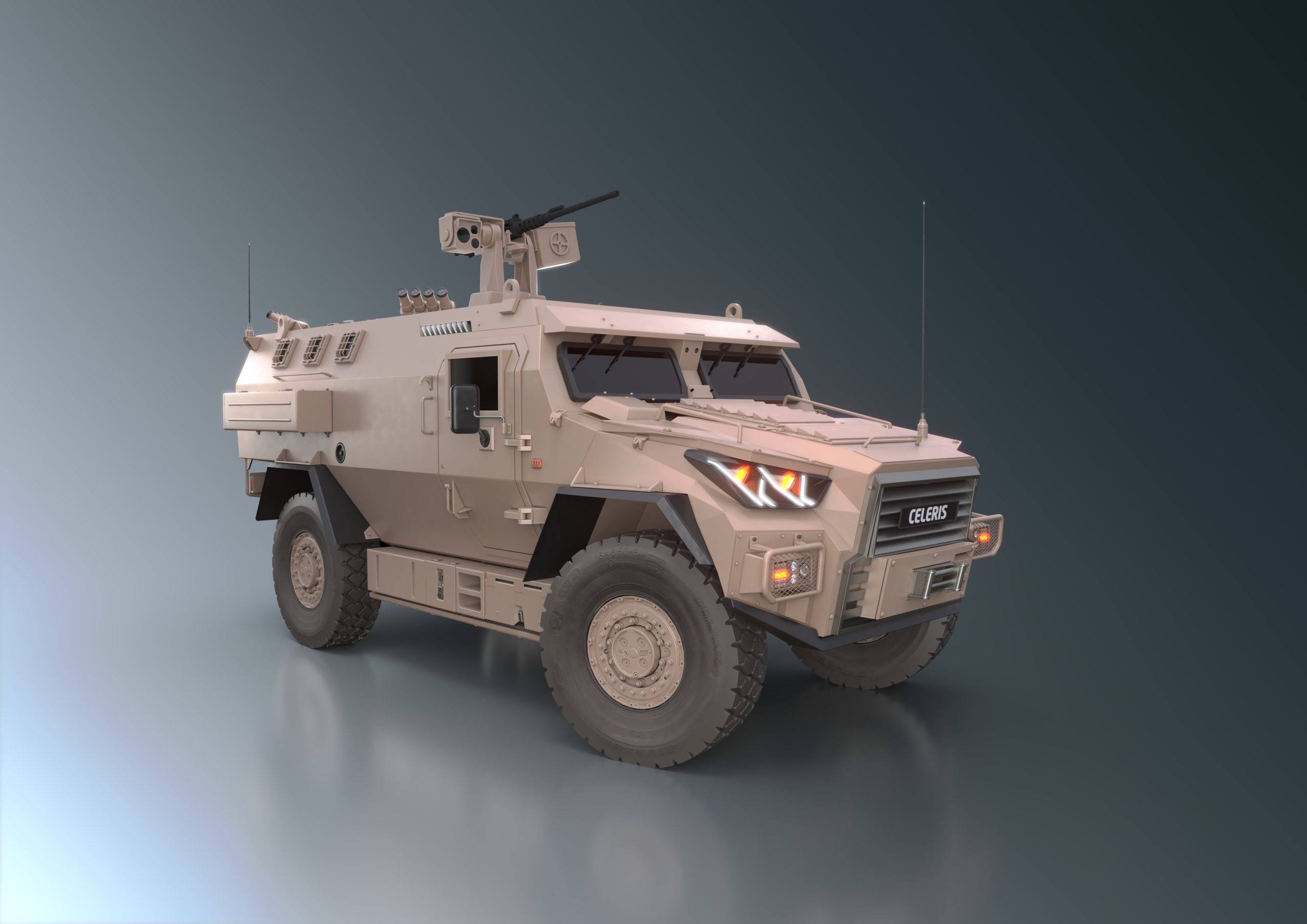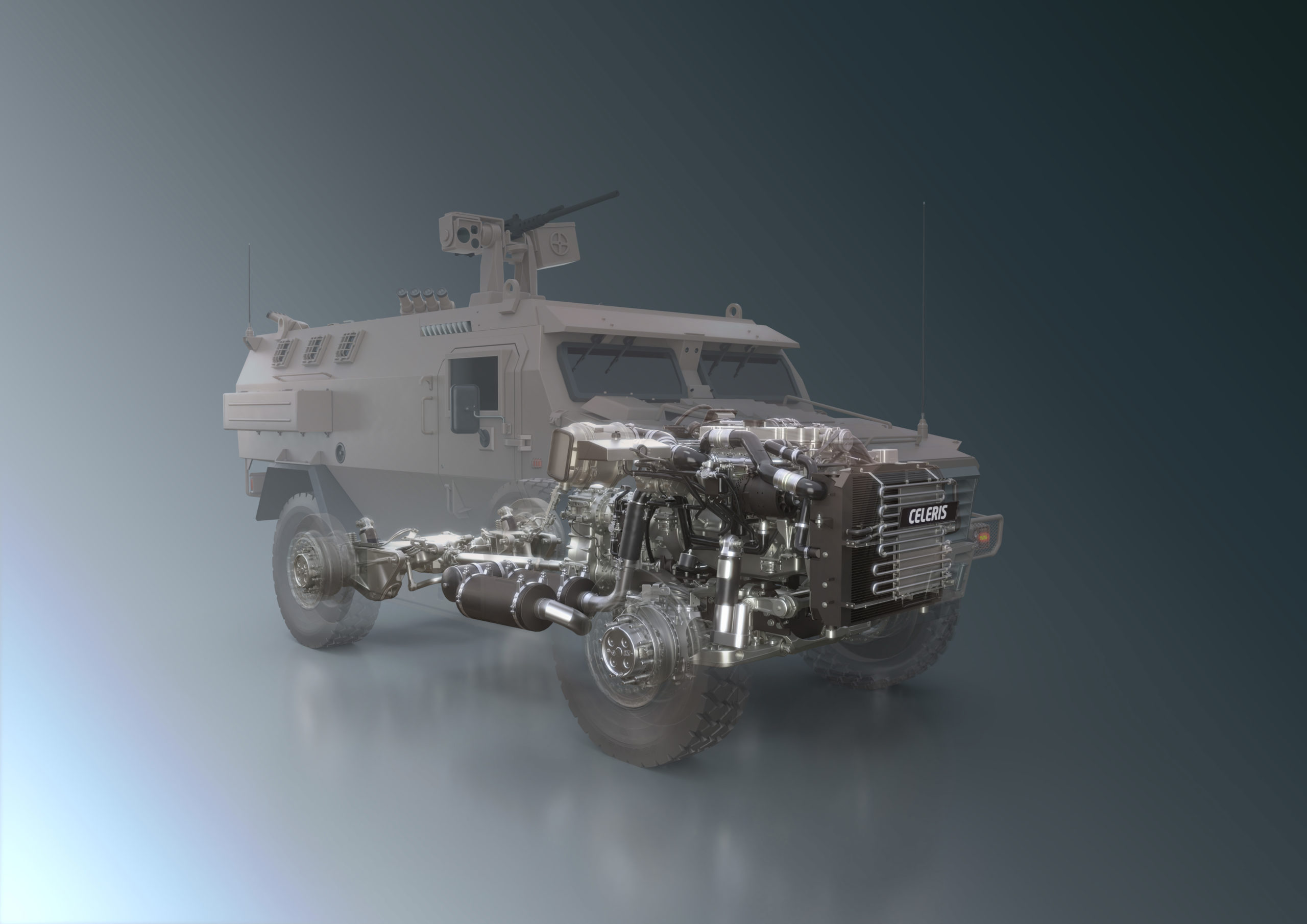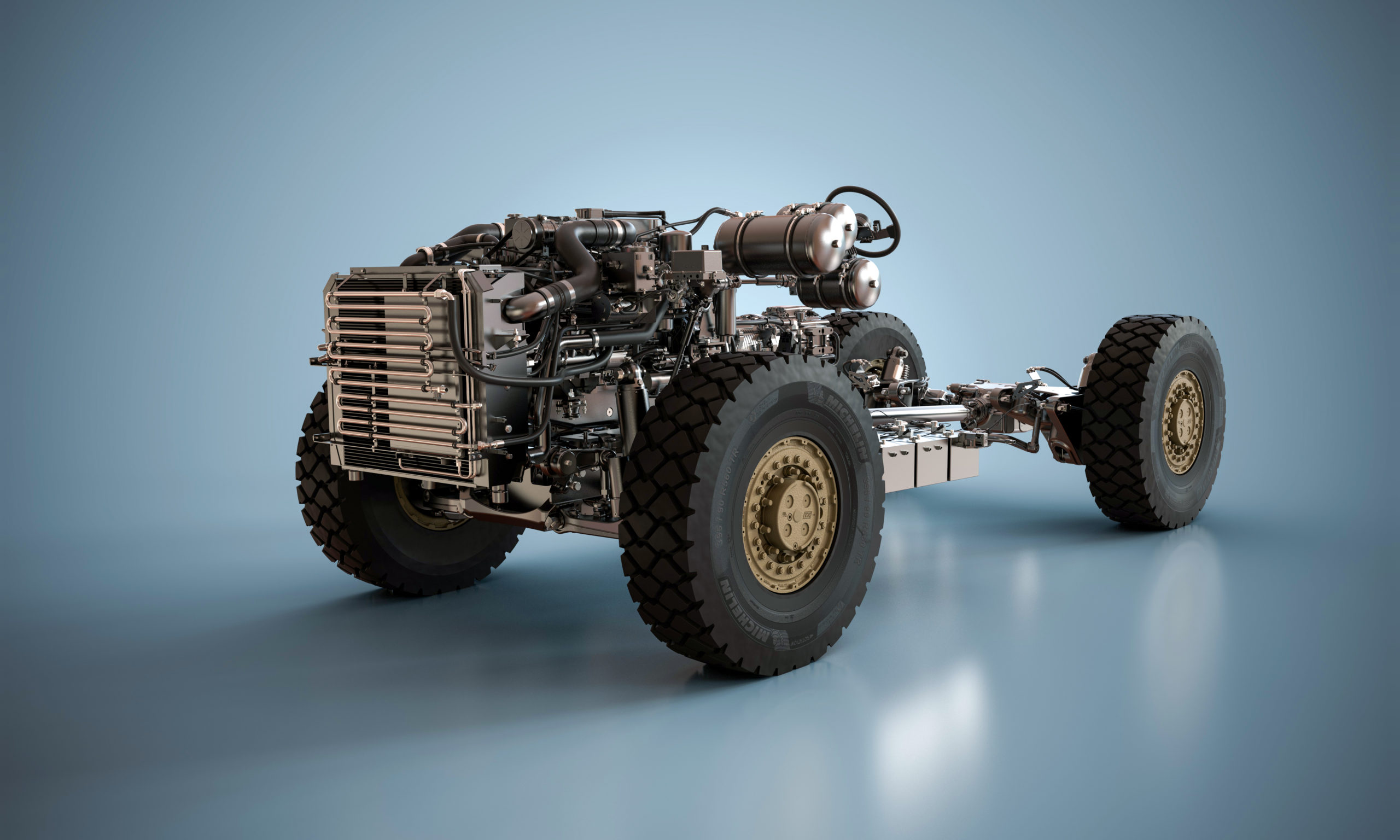By Pierre Tran
Paris – Texelis, a builder of mobility packages for armored vehicles, is working on an electric motorized wheel as an alternative to conventional drivelines, chief executive Jean Vandel told the Association des Journalistes de Defense, a press club.
The company is developing and investing in new technology, including the “hybridization of mobility” for the Serval troop carrier, he told the AJD press club on April 24.
A hybrid vehicle consists of a diesel/electric system, while the present French army Serval troop carrier is powered by a conventional diesel engine and driveline.
The growth in sales and profit from supplying the conventional mobility packages for Serval allows Texelis to fund development of future hybrid diesel/electric systems for army vehicles.
A set of independent electric-powered wheels could deliver 20 to 30 times greater power and boost autonomy by 30 percent on a four-wheel-drive vehicle, Vandel, chief executive of the company’s defense division, said.
Texelis will display mock ups of its work on the electric wheel technology at the upcoming Eurosatory trade show, he said.
The technology concept relates to an “in-wheel electric hub drive,” the company spokesman said. Such an electric hub drive would change the architecture of vehicles, as a power source in each wheel would lead to a smaller diesel engine.
The company is working on maturing the concept, and expects to deliver a technology demonstrator in 2027-2028, the spokesman said.
Texelis and its U.K. partner Qinetiq said May 18 2021 the two companies had entered a “strategic partnership to deliver in-wheel electric hub technology,” with the British company bringing “electrification technology and expertise.”
While engineers explore the electric hub technology, the company is building and delivering a mobility package for the Serval, which is being shipped to the French army.
Texelis supplies the Serval mobility package, which includes a Cummins engine, Allison gearbox, suspension, and axle. The company is also promoting an export version of that package, dubbed Celeris.
Vandel is chief executive of the defense division of Texelis, a medium-sized company based in Limoges, central France. There is also a chief executive managing the civil division, building equipment for public transport systems.
The Eurosatory trade show for land weapons and air-land systems is due to run June 17 to 21.
Sales and Profit Growth
Texelis profitability is around 10-11 percent of annual sales, Vandel said.
The company has seen rapid growth, reporting 2023 sales of €110 million, an 80-percent rise over four years, the company said.
Military sales accounted for 57 percent, and public transport 43 percent. Vandel forecast the former to account for a larger share in the coming years.
Sales are forecast to rise to around €200 million in 2027.
Service support accounts for 20 percent of sales, and that is also expected to rise. Potential growth is seen with the French army requirement for service of its fleet of BAE Systems Hagglunds VHM high mobility tracked vehicles.
The 2024-2030 military budget law “is very positive” for Texelis, the chief executive said, with “visibility for orders” for almost 10 years.
In addition to the initial batch of Serval models, further requirements are being sought, namely anti-drone and mine countermeasures. There is study for an unmanned vehicle with a robot arm and sensors for an anti-mine capability.
The military orders are seen as offering greater security than civil public transport deals, the chief executive said.
There are expectations of “clear acceleration” for the Serval in 2026 in the military budget law, after a “stabilization in 2024,” the company said.
Serval Serves as Lever
The Serval is the light version of the véhicule blindé multi-role (VBMR), a troop carrier, a key element in the French army €10 billion ($10.8 billion) Scorpion modernization program.
The Serval can be seen as something of a breakthrough deal for Texelis, lifting the company to the sought after status of joint prime contractor, after winning with KNDS France, formerly Nexter, a competition held by the Direction Générale de l’Armement procurement office. Texelis was previously a subcontractor, and a supplier of axles and service on the French army VCBI infantry fighting vehicle.
The industrial partners, KNDS France and Texelis, signed the Serval contract in 2018. The latter receives about a third of the value of the vehicle, with the remaining amount shared equally between the KNDS France – which supplies the armored hull, and Thales – which supplies onboard electronics.
Other companies understood to have bid for the Serval deal included Engie Ineo partnered with an Austrian company, Achleitner; KNDS France; Arquus; Soframe; and Thales.
KNDS France builds the four-wheel-drive aluminium armored Serval at Roanne, central France, where the company assembles the Griffon VBMR heavy armored troop carrier and Jaguar combat and reconnaissance vehicle, other major elements of the Scorpion program. There is also a MEPC mortar version of the Griffon, armed with a Thales 120 mm mortar.
Besides the Serval, Texelis is also supplying a mobility package for the VLTP, a light tactical vehicle, which runs separately from the Scorpion project.
The company expects to build 110 mobility packages this year, comprising the Serval and Celeris export systems.
The serval is a wild cat in sub-Saharan Africa, which kills with a bite to the head or the neck. The French army used that same feline name for its 2013 operation in Mali, a bloody combat intervention which halted Islamist rebel fighters advancing on Bamako.
Celeris for Exports
Texelis has also sold a version of the Serval mobility package under the Celeris brandname to Canada and Indonesia, and is pitching in other export markets. The Indonesian order is for the special forces.
The unit price of the Celeris package is some €240,000-€300,000.
There are also expectations of delivering 350-400 French light armored vehicles to the Belgian army, under the Capacité Motorisée (CaMo) program, perhaps between 2026-2030 or 2031. Those would be on top of the 382 Griffons and 60 Jaguars ordered by Belgium under the CaMo project.
In export markets, Texelis delivered last year its T700 axle for a total 44 four-wheel-drive military vehicles split between the Yugoimport Milosh for the Serbian army and GTP Sisu for the Finnish army.
Also last year, there were shipments of its T900 axle for 18 eight-wheel-drive Yugoimport Lazar 3 armored vehicles.
In 2024, T700 axles are due to be shipped for 60 four-wheel-drive Milosh and Sisu vehicles, and T900 axles for 30 eight-wheel-drive Yugoimport Lazar 3 vehicles.
Unimog is a big competitor in the world market.
Celeris is the name of a four-star constellation, and refers to either the son or brother of Pegasus, the winged horse. Celeris means speed or celerity.
Doing The Numbers
The DGA delivered to the army its 200th Serval on 29 January, the procurement office said in a March 7 statement. That brought to 19 units handed over to the service in 2024 at the date of the DGA statement, out of a total 103 to be shipped this year.
There was an initial order for 364 Servals signed in December 2020, followed by an order for a further 420 units signed in December 2023, the DGA said. The 2024-2030 military budget law sets a target of a total 978 Servals in the Scorpion program, seeking to support the forces in high intensity conflict, the procurement office said.
There will be a further order for 1,060 Servals for the VLTP light tactical vehicle, due to run to 2033, the office said.
That brings the requirement for mobility packages for 2,308 vehicles.
The French army has a requirement for a new armored engineering vehicle, offering further prospects for mobility packages.
There are also potential sales with the French project for the Véhicule Blindé d’Aide à l’Engagement (VBAE), a replacement for the VBL scout car. Belgium has signed up as partner on that planned VBAE procurement.
Arquus and Nexter have signed a two-year contract worth €15 million for a “pre-design” architecture study for the VBAE vehicle, with John Cockerill Defense, a Belgian company, as a major subcontractor.
Arquus has worked on its Scarabée hybrid diesel/electric armored vehicle, seen as a contender for the VBAE requirement. The company presented a new version of its concept vehicle at the 2022 Eurosatory show, with an MBDA Akeron MMP anti-tank missile fitted to the turret.
Soframe, a private company, has worked on its concept, dubbed Mosaic, for the VBAE requirement.
The featured image of Celeris was provided by Texelis.
Additional photos of the Celeris in the slideshow below are credited to the company as well.
A press release from Texelis in French highlights the launch of the Celeris.
TEXELIS lance CELERIS et change de dimensionA translation by Second Line of Defense of the first part of the press release follows:
Developing a new 4×4 or 6×6 military vehicle represents a real technical challenge, requiring mastery of numerous technical fields, from mobility to armor and systems integration, not to mention electrical and electronic architecture, support systems and adaptation to capability or doctrinal choices, all in a market that is by nature highly competitive.
Complete high-performance turnkey mobility
There are two possible strategies for developing a new 4×4 vehicle.
The first is to build on the basis of a commercial chassis, thus benefiting from economies of scale and easy access to components and spare parts. However, the use of a commercial chassis does not provide adequate performance, gives no control over components or their parameterization, and guarantees neither access to spare parts nor obsolescence management over the vehicle’s lifetime. In addition, the chassis has to be adapted to military requirements, which calls for a wide range of skills in all the technical fields of mobility, as well as a major effort to identify and qualify suppliers – in other words, a long and complex job, with limited savings, limited performance and a challenge in terms of time and resolving technical problems.
The other strategy is to develop a tailor-made mobility solution. This strategy guarantees the desired level of product performance, component control and definition evolution throughout the life of the vehicle, a comprehensive support system, and a perfect match with the real needs of end-users. However, in-house development is a costly solution that is only suitable for large-scale programs with large production runs.
With CELERIS, Texelis offers the best of both worlds: a complete solution, already developed and qualified, perfectly adapted to military requirements, fully customizable, giving partners their own mobility solution, designed to meet all their needs, with a performance/price ratio unrivalled in this segment.
CELERIS: a modular approach
In its 4×4 configuration, CELERIS comprises 12 basic kits, including axles, powertrain or steering, and over 30 option kits, depending on the desired configuration, or the type of environment in which the vehicle is to operate. A high-performance solution, CELERIS has been developed in compliance with NATO standards.
Thanks to its modularity, CELERIS can accommodate both self-supporting bodies and chassis-mounted architectures, enabling a wide range of architectures and uses. The 4×4 version can accommodate vehicles with a Gross Vehicle Weight Rating (GVWR) of between 13 and 18 tonnes.
CELERIS 4×4 is built around Texelis T750 axles, with a rear axle available with both trailing arms (maximum load 9.5 tonnes) and double wishbones (maximum load 8.5 tonnes). The powertrain combines a 375 hp Cummins ISL9 Euro 3 diesel engine with an Allison 3200SP two-speed transmission.
Thanks to this modular approach, it is possible to select certain kits and combine them with other components, enabling certain players to create or develop strategic competencies.




